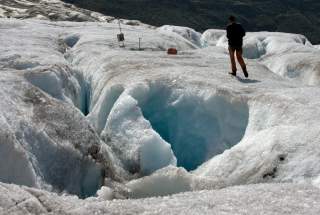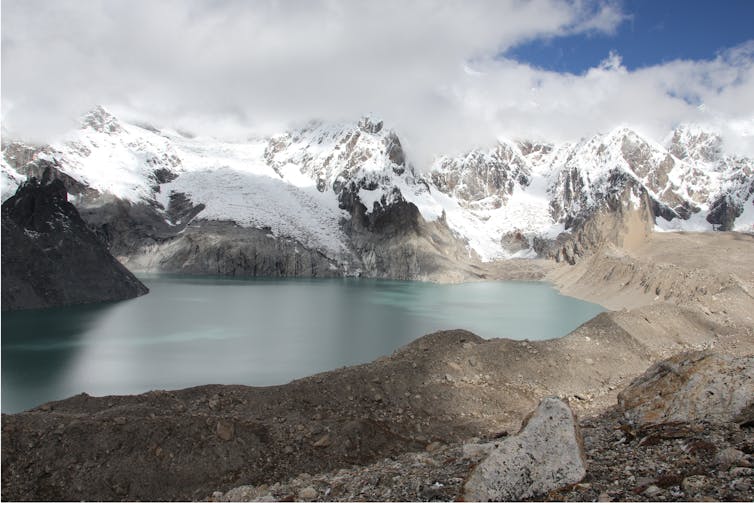New Research: How Meltwater Lakes Contribute to the Accelerating Shrinkage of Glaciers
A breakdown of the latest research.
There are almost 22,000km² of glacier ice in the Himalaya, the spectacular arc of mountains that stretches from north-west India to south-east China. These glaciers are the source of mighty rivers such as the Ganges, the Indus and the Brahmaputra, which hundreds of millions of people depend on for their daily needs.
For scientists, the behaviour of glaciers provides the clearest indication of climatic change in high mountain regions. Recent research has shown that most glaciers in the Himalaya are shrinking, most likely because of long-term increases in temperature. The contribution of glacier meltwater to river flow cannot be sustained over long periods of glacier shrinkage, which means the sustainability of river flow in south-east Asia will soon be at risk.
Over the past few decades, the increasing meltwater yield from glaciers has led to the formation of thousands of new lakes high in the Himalaya, where not all of it drains instantly downstream. These lakes can form directly at the head of retreating glaciers, buffered by big piles of rock debris that the glacier has carried down, called terminal moraines, which signal the glacier has gone as far as it can go. Lakes can also form in large basins hollowed out of the bedrock by a glacier, or even on top of flat, slow-flowing, debris-covered glaciers.
The impact of this widespread development of meltwater lakes has never been studied in detail. But now our research shows that the formation of new glacial meltwater lakes over the past few decades is having an amplifying effect on glacier retreat across the Himalaya, driving a recent increase in the loss of ice across the region.
Satellite spying on glaciers
To examine glacier behaviour over a similar period to that of the newly formed lakes, we used declassified US Hexagon KH-9 spy satellite images, which captured the state of Himalayan glaciers as early as 1973. Combined with data from the Shuttle Radar Topographic Mission in 2000 and data from modern-day satellites, we created three-dimensional models called digital elevation models (DEMs) of the surface of approximately 7,500km² of Himalayan glaciers.
By examining the differences in the surface elevation of glaciers at different points in time, we were able to measure how quickly glaciers across the region have thinned over the past five decades. We found that since the 1970s, glaciers flow down into lakes have thinned at around twice the rate (up to four metres a year since 2000) of glaciers flowing down on to land. We also showed that the difference in the rate of ice loss between glaciers flowing into a lake and on land has widened since 2000.

We also looked at how the position of the front of the same glaciers has changed since the 1970s. Again, glaciers that are now flowing into these new meltwater lakes retreated at more than twice the rate (an average of 26 metres per year since 2000) than glaciers flowing on to land (an average of nine metres a year). Since the 1970s glaciers that are now flowing into lakes reduced in length by an average value of 13%, but by as much as 49% in some cases. Glaciers flowing on land reduced in length by an average of 9%.
The future of Himalayan glaciers
The areas of High Mountain Asia covered in glaciers are warming at a higher rate than the global average. Even under the most conservative Intergovernmental Panel on Climate Change (IPCC) RCP2.6 scenario (which explores the possibility of keeping average global temperature increase below 2°C) a 1.5°C increase of global temperatures will cause 2.1°C of warming in High Mountain Asia. Such a rise in air temperatures will ensure continued glacier retreat in the region. While rain may increase in the Himalaya in coming decades, snowfall is not predicted to increase to counter glacier melt.
The continued expansion of current glacial lakes combined with the formation of more new lakes will amplify ice loss levels above that caused by temperature increases. The existence of a glacial lake at the front of a glacier causes enhanced melting when warmer lake water makes contact with the ice, which then produces “calving” – the detachment of large chunks of ice from the front of a glacier.
Further work examining how widespread the right conditions are for further glacial lake formation across the region is vital if we are to understand the different scenarios of glacier evolution high in the Himalaya. The continued monitoring of glacier retreat will provide the clearest indication of the impact of global warming on this unique but fragile region.
![]()
Owen King, Research Fellow School of Geography & Sustainable Development, University of St Andrews
This article is republished from The Conversation under a Creative Commons license. Read the original article.
Image: Reuters


